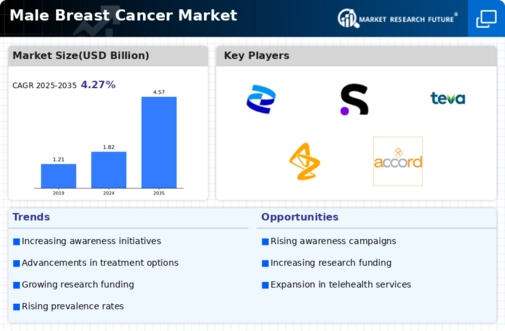Male Breast Cancer Size
Male Breast Cancer Market Growth Projections and Opportunities
Male breast cancer is rare but still significant within the larger spectrum of breast cancer. The market for male breast cancer is receiving more attention as awareness is growing and diagnostic capabilities are improving in a number of ways. Breast cancer in men, traditionally considered predominantly a female condition, constitutes less than 1% of all incidences of the disease. Nonetheless, male patients affected by this condition need a lot of research targeted at them, specialized treatments and also heightening of awareness.
Lately there has been increasing recognition of unique features presented by the male breast cancer leading to increased levels of research and development activities targeting this particular patient population. Diagnostic procedures for male breast cancer market have improved especially with the introduction such genetic tests as DNA tests to identify vulnerable individuals. These innovations enable early detection, personalize treatment modalities thereby improving overall results for men.
The treatment choices for male breast cancers have historically been identical to those applied to their female counterparts such as surgery, chemotherapy, radiation therapy or hormone therapy. Nonetheless, there is ongoing research that aims at developing customized therapeutic approaches which take into account distinctive characteristics exhibited by male breast cancers from their female types. Clinical trials play a crucial role in testing new drugs and strategies specifically designed for males aimed at enhancing better chances of survival and improved quality life expectancies.
Awareness campaigns against stigmatization surrounding men’s breast cancer are also gaining momentum in the male breast cancer marketing field calling for frequent screenings thus removing stigma around it. It goes without saying that public health initiatives coupled with educational programs should be employed so that early detection can occur; this greatly determines how successful treatment could turn out to be if done at an earlier stage rather than later when it would be too late to begin any intervention. Furthermore, client-based care networks have come up specifically meant for males having breasts suffering from this killer disease assisting them emotionally during treatment as a form community away from home.
A limited understanding regarding the pathogenesis behind this disease and considered as orphan diseases is a challenge to the male breast cancer market. It becomes difficult to develop targeted therapies because there are no comprehensive data sets, or large-scale clinical trials in rare cases of male breast cancer. Addressing these problems will require collaboration among healthcare professionals, researchers, and policymakers to focus on research for male breast cancer and allocate resources accordingly.
The evolving nature of the market for male breast cancer has seen an increased realization that what is needed goes beyond mere medication. This means not only improved medical treatments but also psychological well-being and emotional support received by such patients. The integration of psychosocial care into the male breast cancer treatment paradigm can greatly enhance the overall wellbeing and resilience of patients.


















Leave a Comment